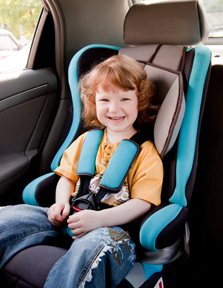|

Car seat safety is one of the top questions at many of my well child exams. While most parents know that their children need to be in some form of safety restraint system, they are often unsure when to transition from one stage to the next.
Children's Physicians Medical Group Blog: www.cpmgsandiego.com/blog
Now add in the changing recommendations and that makes for even more confusion. The American Academy of Pediatrics (AAP) makes their best-practice recommendations for Car Seat Safety, but each individual state mandates their own laws. In April 2011, the AAP changed their recommendation with two key suggestions:
First, the AAP advises parents to keep their infants and toddlers in rear-facing car seats until age 2, or until they reach the maximum height and weight recommendations for their car seat. This, however, does not mean that you can turn them forward facing prior to 1 year of age. Since this is only a recommendation you are not required to keep them rear facing until 2 years, however, it is the safest way to travel. In addition, there are many convertible car seats that allow your child to remain rear facing until 2 years of age and then change to forward facing. Remember, you should always follow the manufactures instructions, along with maximum height and weight guidelines. Finally, it is the law that they remain rear facing until 1 year of age AND 20 pounds. Both of these requirements must be met before you can turn them around.
The second recommendation is that children will need to ride in a belt-positioning booster seat until they have reached 4 feet 9 inches tall and are between 8 and 12 years of age. California adopted this recommendation and is making it the law.
The new California Law begins on January 1, 2012 and states “Children MUST be secured in an appropriate child passenger restraint (safety seat or booster seat) IN THE BACK SEAT OF A VEHICLE until they are at least 8 YEARS OLD or 4’9” in height”. It is also highly recommended that children ride in the rear of a vehicle until they are 13 years old.
So those are the newest AAP best-practice recommendations and the new California law. Now for a quick run down on where these recommendations come from. A rear-facing car seat does a better job supporting the head, neck and spine of infants and toddlers in a crash, because it distributes the force of the collision over the entire body. A 2007 study published in the Journal of Injury Prevention showed that children under the age of 2 are 75% less likely to die or be severely injured when they ride rear facing. Although the rate of deaths in motor vehicle accidents in children under 16 has decreased since 1997, with over 5,000 deaths per year it is still the leading cause of death in children 4 years of age and older. Moreover, for every fatality there are 18 hospitalizations and 400 injuries requiring medical attention. Finally, most children between 2 and 8 years of age are not large enough to fit properly in the vehicle lap and shoulder belt, and will require a child safety seat or booster seat for optimal restraint. Riding in the backseat in a proper fitting child safety seat, booster seat, and lap and shoulder belt should help reduce the number of injuries and fatalities.
I often remind parents how difficult it can be to be a good parent. Additionally, it is much more important to be that good parent than to make your child happy. Please follow the AAP best-practice recommendations by keeping your child rear facing until 2, placing them in a booster seat no sooner than 4 years AND 40 pounds, making sure that they ride in the backseat in a proper fitting child safety or booster seat until 8 years or 4’9” tall, and keeping them in the backseat until 13 years of age. We can only control so much of our environment. By following these important laws and guidelines you can help ensure that your child is as SAFE as possible while riding in the car. |